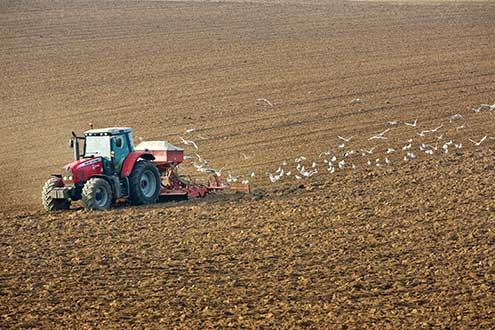Effective spring cropping aids weed control

Most growers who switch to spring cropping are doing so for one reason – to improve control of problem weeds proliferating under a regime of continuous autumn cropping, dominated by wheat and oilseed rape.
Key targets include blackgrass, poppy, cranesbill and, increasingly, chickweed. Spring cropping allows extra time for cultural control methods and weeds that do appear will be smaller and more vulnerable to crop competition and herbicides.
However, a good management plan is vital to achieve a favourable outcome, says Dick Neale, technical manager at Hutchinsons. “That means effectively managing overwintered fallow to gain initial control of weeds, planting the right crop at the right time in the right conditions and choosing an effective herbicide programme.”
Cultural control, particularly the use of stale seed-beds, is the primary consideration, says Mr Neale. “These weeds are becoming a problem because of a lack of focused husbandry. Too many growers think they can use herbicides to paper over the cracks. Increasingly, they can’t.”
Given the greatly reduced ability of blackgrass to head in the spring – Rothamsted work has shown April-emerging plants produce an average of just 0.7 heads compared with 15 from those emerging in the autumn – an effective stale seed-bed programme creates a great opportunity for spring cropping to reduce seed return, says Mr Neale.
But growers must resist the temptation to take stewardship payments on overwintered stubbles, he warns. “This immediately locks you out of any operations right through to 14 February. By that time it is too late for effective stale seed-beds, even if you can move the soil.”
Two or three shallow soil movements can be used through the autumn, creating a flush of weeds that can then be killed with glyphosate. A further stale seed-bed should be created ideally a month before drilling, he adds.
“This can even be achieved with a rake. You may not be drilling until mid-March or later. However, there is no point rushing in if blackgrass is bad – you stand to lose a lot of yield and most of the spring cropping benefits.” A further glyphosate spray should be applied 24-48 hours before drilling to control all annual weed seedlings, ensuring the crop has a clean start, says Mr Neale.
Seed-beds should be fine and firm to maximise pre-emergence herbicide activity and warm enough to encourage rapid germination and emergence to help the crop compete with weeds. “These are all features of overwintered seed-beds created using surface tillage,” says Mr Neale. “To help further, keep seed rates up.”
Choosing a crop that offers the best chance of effective blackgrass control is key, says Mr Neale. That leaves just two – spring barley or spring oats. Both are alleliopathic – they exude substances from their roots that restrict the growth of other plants, including blackgrass, making it easier for them to outcompete the weed.
Spring wheat is much less competitive and has a very limited chemical armoury available, and the same is true for many broad-leaved crops, he adds.
Spring barley offers a wider choice of herbicide choices than spring oats, so for many growers it will be the obvious choice, says Mr Neale. Flufenacet (plus pendimethalin as Crystal or plus DFF as Liberator) can be used at half rate in spring barley under an extension of authorisation for minor use (EAMU). Defy (prosulfocarb), Hekla (chlorotoluron + diflufenican) and Sempra/Hurricane (diflufenican) are also available under EAMUs. Avadex (tri-allate) has full label approval.
This provides several options to stack chemistry to control blackgrass as well as annual meadow grass, wild oats and a wide range of broad-leaved weeds.
Spring oats can be nearly as effective as spring barley, provided cultural control has worked well and they are drilled into a good seed-bed. “You are relying on straight DFF pre-emergence to support the crop in grassweed control.”
Growers with ALS-resistant poppies should avoid broad-leaved spring crops, says Mr Neale. “There are limited anti-resistance options, so you have to stick with crops such as spring barley, oats or wheat, where you can use MCPA or, for spring barley only, pendimethalin as Crystal.”
The latter followed with Avadex will leave very few broad-leaved weeds, including resistant chickweed, he adds.
| EAMUs explained |
|---|
| Many products for use on spring crops are available under extensions of authorisation for minor use (EAMUs), says Dick Neale (pictured below). “They are granted use on very limited crop safety data. Although in theory the crop should be fine, there are occasions when it might not be. Growers need to be aware that use of EAMUs is at their own risk with regard to crop safety.” To reduce the risk growers and agronomists need to keep abreast of key parameters, including crop sowing dates, use rates, timings and application dates. “EAMUs are a moving target and can be quite complicated when it comes to what you can legally do and not do. Be sure to read the information thoroughly.” |
Northern weed control options
In non-blackgrass situations further north and into Scotland, weed control in spring barley falls into two camps – one with other grassweeds and broad-leaved weeds to control, and another with broad-leaved weeds only.
| Herbicide actives |
|---|
|
Meadow grasses are the most important grasses, though ryegrass and occasionally wild oats also need controlling. All are increasing in min-till and reduced tillage systems, says SRUC senior weeds consultant Mark Ballingall.
“In a wet summer the last thing you want is a mat of meadow grass at the bottom of a crop. As well as the yield effect, it holds a lot of moisture, so can delay harvest.”
Chlorotoluron mixtures are being revoked, so only very limited on-farm supplies will be available next spring. This leaves growers two main options.
“Liberator can be used at a maximum dose of 0.3 litres/ha pre- or early post-emergence. If the seed-bed is dry it needs a follow-up for broad-leaved weed control – it is not so clever on fumitory or polygonums,” says Mr Ballingall. “Stomp Aqua has label approval and is another useful option, though it does need more moisture than Liberator.”
Problem broad-leaved weeds include fumitory, polygonums and chickweed, which is becoming increasingly resistant to sulfonylurea herbicides. Adding fluroxypyr is one solution, or Spitfire, which offers alternative chemistry and good control of cleavers, could be used. However, where fumitory and polygonums are a problem, a decent rate of dicamba + mecoprop may be a better option, he adds.
Spring oats, another popular option in the North, need a bit more care, he advises. “You can use the same chemistry, but don’t overdo the tank mixes and be aware that the crop is less tolerant of sulfonylureas.”
Pulses
Spring-sown pulses can help beat the blackgrass threat, but effective stale seed-bed control is vital, says PGRO principal technical officer Jim Scrimshaw.
“When it comes to chemical control we are struggling. We have largely relied on fops and dims, such as Laser and Aramo, which more growers report as not performing to expectations. Pre-emergence we have materials such as Defy that appears
to have some activity, but it needs a partner such as Stomp to widen control of broad-leaved weeds. Avadex also has some activity against blackgrass.”
Nirvana is a reasonably effective pre-emergence herbicide on meadow grass, but even at full rate (4.5 litres/ha) struggles to control blackgrass effectively. It kills a broad spectrum of broad-leaved weeds, notably polygonums, but is weak on groundsel, field pansy, fool’s parsley, shepherd’s purse and cleavers.
Linzone will control those weeds (except pansy) and meadow grass. “Applied at 2 litres/ha it is quite far reaching and is effective on cleavers,” says Mr Scrimshaw.
Stomp has label approval in combining peas and an EAMU for beans and will control meadow grass and broad-leaved weeds, but is weak on charlock, fool’s parsley, groundsel and cleavers.
Post-emergence products are limited to Basagran in beans and Basagran and MCPB in combining peas. “Ideally it needs to be warm, bright and the weeds small. Basagran is weak on blackgrass, knotgrass, meadow grass and pansies, though a split application, in beans only, can help. MCPB is useful against oilseed rape, thistles and docks, but be careful not to damage peas, especially if using in a mixture with bentazone.”
Linseed
Most fops and dims can be used on linseed to clear up wild oats, but their ability to control blackgrass is limited, says United Oilseeds area manager Richard Elsdon.
He emphasises the need for good pre-drilling control. “Playing catch-up with weeds is never very successful and always expensive. Many farmers will grow linseed to avoid giving blackgrass another free ride on cereals, so they should look seriously at Avadex. This must be applied immediately post-drilling and rolling to give the best control of blackgrass and wild oats.”
This will also help the performance of fops and dims such as Aramo, Falcon, Fusilade or Laser, as they work best on small weeds. “Avadex also gives useful control of broad-leaved weeds. There is a good range of sulfonylureas, either as label recommendations or EAMUs, that will finish the job,” says Mr Elsdon.
Half-rate Jubilee and Eagle applied 10 days apart is a cost-effective option, controlling a range of weeds including cleavers. Chekker can also be used as a single application.
“Provided growers keep on top from the start, a programme such as this should cover all known ills,” says Mr Elsdon.

Mark Ballingall says grassweeds such as meadow grass, ryegrass amd wild oats are increasing in min-till and reduced tillage systems.

